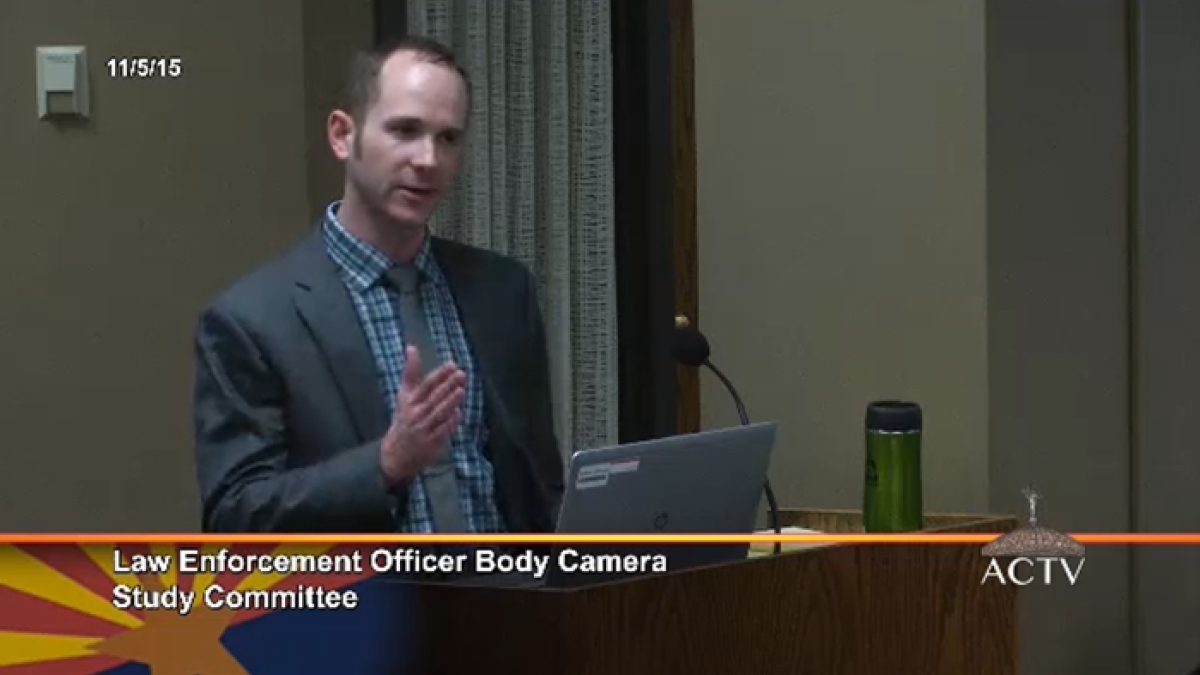ASU criminology professor briefs lawmakers on impact of police officer-worn video cameras

Jacob Young, an assistant professor in the School of Criminology and Criminal Justice, talks about research on police officer body-worn cameras to a legislative study committee.
Jacob Young, an assistant professor at the School of Criminology and Criminal Justice in the ASU College of Public Service and Community Solutions, told a legislative study committee that research suggests body-worn video cameras influence the behavior of police officers.
His comments were based on several peer-reviewed studies and data obtained through an ASU study with Mesa Police. Young told members of the Law Enforcement Officer Body Camera Study Committee about the study’s three key findings. The first focused on whether officers with body-worn cameras were more or less likely to initiative encounters with citizens. “Officers who wore a camera were much more likely to issue a citation than officers who didn’t wear a camera,” Young told the committee. “And they are much more likely to initiate encounters with citizens.”
The Mesa study involved 50 officers who were given body-worn cameras and 50 officers who did not wear cameras. Both groups tracked their daily interactions with citizens for nearly a year.
Young told the committee that the second key finding was that officers who wore the camera were more likely to find cameras useful in doing their job.
“Compared to those who didn't have a camera …, officers who wore cameras though it was more useful,” Young said. “And this is consistent with research on the use of technology — showing that people who see it as useful are much more likely to then use it.”
Of the 50 Mesa Police officers that wore cameras, 25 had volunteered to wear then and 25 officers were randomly-assigned to compulsorily wear a camera. When the study began, all participating officers were required to turn on their camera for every encounter with citizens. But after five months, officers were given the discretion to activate cameras when they thought appropriate. Young told the study committee that there was a distinct difference in the activation of cameras between the two groups of officers.
“Compulsorily assigned officers were three times more likely to stop activating their cameras when the policy switched to discretionary activation relative to the volunteer officers,” Young said.
One of the committee members is Colonel Frank Milstead, director of the Arizona Department of Public Safety. He was Mesa Police chief at the time of the study and says officers are now embracing the new technology.
“The desire to have them is much greater as the world has continued to change and the media has continued to paint law enforcement with this broad brush of negativity and trust,” Milstead said. “The officers want to show that they are doing the right things, most of the time.”
Earlier in the committee hearing, a legislative analyst told committee members that six of the state’s 15 sheriff’s departments and 30 local police agencies use body-worn video cameras.
The Law Enforcement Officer Body Camera Study Committee will hold future hearings to examine policies about when cameras should be turned on and off and what recordings should be released to the public. The committee will ultimately make recommendations that could be used to craft legislation on the use of body-worn cameras by state and local police agencies in Arizona.